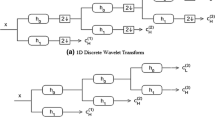Abstract
In epilepsy diagnosis or epileptic seizure detection, much effort has been focused on finding effective combination of feature extraction and classification methods. In this paper, we develop a wavelet-based sparse functional linear model for representation of EEG signals. The aim of this modeling approach is to capture discriminative random components of EEG signals using wavelet variances. To achieve this goal, a forward search algorithm is proposed for determination of an appropriate wavelet decomposition level. Two EEG databases from University of Bonn and University of Freiburg are used for illustration of applicability of the proposed method to both epilepsy diagnosis and epileptic seizure detection problems. For this data considered, we show that wavelet-based sparse functional linear model with a simple classifier such as 1-NN classification method leads to higher classification results than those obtained using other complicated methods such as support vector machine. This approach produces a 100 % classification accuracy for various classification tasks using the EEG database from University of Bonn, and outperforms many other state-of-the-art techniques. The proposed classification scheme leads to 99 % overall classification accuracy for the EEG data from University of Freiburg.







Similar content being viewed by others
References
Adeli H, Ghosh-Dastidar S, Dadmehr N. (2006) A wavelet-chaos methodology for analysis of EEGs and EEG sub-bands to detect seizures and epileps. IEEE Trans Biomed Eng 54(2): 205–211
Adeli H, Zhou Z, Dadmehr N (2003) Analysis of EEG records in an epileptic patient using wavelet transform. J Neurosci Meth 123:69–87
Andrzejak RG, Lehnertz K, Mormann F, Rieke C, David P, Elger CE (2001) Indications of nonlinear deterministic and finite-dimensional structures in time series of brain electrical activity: dependence on recording region and brain state. Phys Rev E 64(6):61907
Chandaka S, Chatterjee A, Munshi S (2009) Cross-correlation aided support vector machine classifier for classification of EEG signals. Expert Systems Appl 36(2):1329–1336
Chen SS, Donoho DL, Saunders MA (2001) Atomic decomposition by basis pursuit. SIAM Rev 43(1):129–159
Chui CK (1992) An introduction to wavelets. Academic Press, New York
Donoho D, Johnstone I, Kerkyacharian G, Picard D (1995) Wavelet shrinkage: Asymptopia. J. Roy Statist Soc B 57:301–369
EEG Database from University of Bonn. http://www.epileptologie-bonn.de/cms/front_content.php?idcat=193. Accessed 10 April 2012
EEG Database from University of Freiburg. https://www.epilepsy.uni-freiburg.de/freiburg-seizure-prediction-project/eeg-database. Accessed 10 April 2012
Fan J, Zhang J (2000) Two-step estimation of functional linear models with applications to longitudinal data. J Roy Statist Soc Ser B 62:303–322
Gribonval R, Figueras I, Ventura R, Vandergheynst P (2006) A simple test to check the optimality of a sparse signal approximation. Signal Process 86(3):496–510
Guo L, Rivero D, Pazos A (2010) Epileptic seizure detection using multiwavelet transform based approximate entropy and artificial neural networks. J Neurosci Methods 193:156–163
Harikrishnana KP, Misrab R, Ambikac G, Kembhavib AK (2006) A non-subjective approach to the GP algorithm for analysing noisy time series. Physica D 215:137–145
Jach AE, Marin JM (2010) Classification of genomic sequences via wavelt variance and a self-organizing map with an application to mitochondrial DNA. Stat Appl Genet Mol Biol 9(1): Art 27
Janjarasjitt S (2010) Classification of the epileptic EEGs using the wavelet based-scale variance feature. Int J Appl Biomed Eng 3(1):19–25
Jenssen S, Schere D (2010) Treatment and management of epilepsy in the elderly demented patient. Am J Alzheimers Dis Other Dementias 25(1):18-26
Kannathal N, Choo M, Acharya U, Sadasivan P (2005) Entropies for detection of epilepsy in EEG. J Med Systems 80(3):187–194
Khan YU, Gotman J (2003) Wavelet based automatic seizure detection in intracerebral electroencephalogram. Clin Neurophysiol 114: 898–908
Mallat S, Zhang Z (1993) Matching pursuit with time-frequency dictionaries. IEEE Trans Signal Process 41(12):3397-3415
Mosquera CG, Trigueros AM, Franco JI, Vázquez AN (2010) New feature extraction approach for epileptic EEG signal detection using time-frequency distributions. Med Biol Eng Comput 48(4):321–330
Nason GP, Sachs R, Kroisandt G (2000) Wavelet processes and adaptive estimation of the evolutionary spectrum. J Roy Stat Soc B 62:271–292
Nason GP, Silverman BW (1995) The stationary wavelet transform and some statistical applications. Wavelets and statistics. In: Antoniadis A, Oppenheim G (eds) Lecture notes in statistics, vol 103. Springer, New York, pp 281–300
Nigam V, Graupe D (2004) A neural-network-based detection of epilepsy. Neurol Res 26(1):55–60
Noachtar S, Rémi J (2009) The role of EEG in epilepsy: a critical review. Epilepsy Behav 15:22–33
Percival DB, Walden AT (2000) Wavelet methods for time series analysis. Cambridge University Press, Cambridge
Polat K, Nes NG (2007) Classification of epileptiform EEG using a hybrid system based on decision tree classifier and fast Fourier transform. Appl Math Comput 187(2):1017–1026
Rankine L, Mesbah M, Boashash B (2007) A matching pursuit-based signal complexity measure for the analysis of newborn EEG. Med Biol Eng Comput 45(3):251–260
Sharanreddy M, Kulkarni, PK (2011) Review of significant research on EEG based automated detection of epilepsy seizures & brain tumor. Int J Sci Eng Res 2(8):1–9
Srinivasan V, Eswaran C, Sriraam NH (2005) Artificial neural network based epileptic detection using time-domain and frequency-domain features. J Med Systems 29(6):147–160
Srinivasan V, Eswaran C, Sriraam NH (2006) Approximate entropy based epileptic EEG detection using artificial neural networkss. IEEE Trans Inf Technol Biomed 11(3):288-295
Subasi A (2007) EEG signal classification using wavelet feature extraction and a mixture of expert model. Expert Systems Appl 32(4):1084–1093
Tzallas A, Tsipouras M, Fotiadis D (2007) Automatic seizure detection based on time-frequency analysis and artificial neural networks. Comput Intell Neurosci:13 (Article ID 80510)
WHO (2009) http://www.who.int/mediacentre/factsheets/fs999/en/. Accessed 02 Feb 2012
Acknowledgments
S. Xie acknowledges the financial support from MITACS and Ryerson University, under MITACS Elevate Strategic Post-doctoral Award.
Author information
Authors and Affiliations
Corresponding author
Rights and permissions
About this article
Cite this article
Xie, S., Krishnan, S. Wavelet-based sparse functional linear model with applications to EEGs seizure detection and epilepsy diagnosis. Med Biol Eng Comput 51, 49–60 (2013). https://doi.org/10.1007/s11517-012-0967-8
Received:
Accepted:
Published:
Issue Date:
DOI: https://doi.org/10.1007/s11517-012-0967-8




